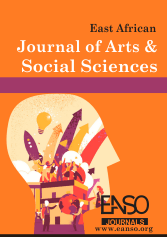Assessing Counter-Terrorism Preparedness in the Hospitality Industry: Evidence from Dusit D2 Hotel, in Nairobi, Kenya
Abstract
This paper quantitatively assessed employee perceptions regarding the operational counter-terrorism preparedness and the adequacy of mitigation strategies at the Dusit D2 Hotel in Nairobi, following the critical 2019 attack. The research employed a quantitative, cross-sectional design, utilising Stratified Random Sampling to survey 110 employees, achieving an 83.3% response rate from the target sample. Data analysis utilised descriptive statistics and One-Way Analysis of Variance (ANOVA) to compare perceptions across three employment cadres: Top Management, Middle Management, and First-level Staff. The findings revealed a critical imbalance in the hotel's security posture. While the organisation shows high confidence in its physical and technological mitigation measures (e.g., Mass Notification Systems and Physical Barriers), its operational readiness is severely undermined by human and procedural deficiencies. The ANOVA results showed a statistically significant difference (p=0.033) in the perceived Overall Operational Preparedness across the employment cadres, confirming a distinct preparedness gradient where confidence diminishes significantly from Top Management to First-level Staff. Further analysis established that an overwhelming 74.0% of all employees deemed the counter-terrorism training to be inadequate, a systemic failure that held true across all hierarchical levels (p=0.331). The study concludes that the hotel's operational resilience is compromised by a critical failure to translate strategic security measures into confident, actionable capabilities among the frontline workforce
Downloads
References
African Union. (2019). Counter-terrorism. Retrieved from https://www.google.com/search?q=https://au.int/en/peace-security/counter-terrorism
AlBattat, A. R., & Mat Som, A. P. (2013). Emergency preparedness for disasters and crises in the hotel industry. Sage Open, 3(3), 2158244013505604.
Boylan, D., & Greenawalt, R. (2021). Crisis Management: Suggestions on How Mandalay Bay Can Survive Disaster. American Journal of Management, 21(3).
Bryden, M., & Bahra, P. (2019). East Africa’s terrorist triple helix: The Dusit Hotel attack and the historical evolution of the jihadi threat. CTC Sentinel, 12(6), 2-11.
Buigut, S. (2019). The impact of terrorism on Kenya’s economy. Journal of Economics and Business, 3(2), 45-56.
Chapman, D. (2019). The challenges of countering terrorism in Africa. Journal of Policing, Intelligence and Counter Terrorism, 14(2), 116-127. https://doi.org/10.1080/18335330.2019.1674103
Federal Bureau of Investigation. (2021). Countering violent extremism. Retrieved from https://www.fbi.gov/investigate/countering-violent-extremism
FEMA. (2022). BIPS 06/FEMA 426: Reference Manual to Mitigate Potential Terrorist Attacks.
Hata, R., Hart, A., Hertelendy, A., Lavoie, A., & LeFevre, A. (2023). Terrorist Attacks in Sub-Saharan Africa from 1970 through 2020: Analysis and Impact from a Counter-Terrorism Medicine Perspective. Prehospital and Disaster Medicine, 38(2), 216-222. doi:10.1017/S1049023X23000080
Hunsicker, A. (2006). Understanding international counter-terrorism. Universal Publishers.
Konrad-Adenauer-Stiftung. (2018). Counter-terrorism in Africa: The need for a comprehensive approach. Retrieved from https://www.kas.de/web/rsc/counter-terrorism-in africa-the-need-for-a-comprehensive-approach/
Krejcie, R. V., & Morgan, D. W. (1970). Determining sample size for research activities. Educational and Psychological Measurement, 30(3), 607-610.
Kumar, R. (2011). Research methodology (3rd ed.). SAGE Publications.
Muindi, B. (2021). Assessing the impact of terrorism and counter-terrorism laws on freedom of the media in Kenya. In M. Ndulo (Ed.), Media, Conflict and Peacebuilding in Africa (pp. 101-112). Routledge.
Musoma, A. L. (2021). Multi Agency Response to International Terrorism in Kenya: A Comparison of Dusit D2 and Westgate Terror Attacks. African Journal of Empirical Research, 2(1&2), 68-84.
Nowell, L. S., Norris, J. M., White, D. E., & Moules, N. J. (2017). Thematic analysis: Striving to meet the trustworthiness criteria. International Journal of Qualitative Methods, 16(1), 1-13.
Oladipo, R. L. (2015). General research methods. Oxford Publishers.
Otieno, F. O. (2019). Counterterrorism strategies and performance of the national police service in managing terrorism in Lamu County, Kenya [Doctoral dissertation, MMUST].
Paraskevas, A. (2012). Aligning strategy to threat: a baseline anti-terrorism strategy for hotels. International Journal of Contemporary Hospitality Management, 24(7), 1026-1042. https://doi.org/10.1108/09596111211248010
Pizam, A. (2009). Hotels as tempting targets for terrorism attacks. International Journal of Hospitality Management, 29(1), 1-10. https://doi.org/10.1016/j.ijhm.2009.10.019
Riunga, D. (2019). Armed private security firms and counter-terrorism in Kenya. University of Nairobi Press.
Saunders, M., & Lewis, P. (2016). Research methods for business students (7th ed.). Pearson.
Tyitende, R. A. (2021). Terrorism and the international counter-terrorism regime in Africa: A U.S. Bureau of Counterterrorism perspective. Country Reports on Terrorism 2019: Kenya. Retrieved from https://www.state.gov/reports/country-reports-on-terrorism-2019/kenya/
United Nations Office on Drugs and Crime. (2021). Counter-terrorism. Retrieved from https://www.unodc.org/unodc/en/terrorism/counter-terrorism.html
United States Department of Homeland Security. (2019). Counter-terrorism strategies. Retrieved from https://www.state.gov/reports/country-reports-on-terrorism-2019/
Wirtz, P. W., & Rohrbeck, C. A. (2018). The dynamic role of perceived threat and self-efficacy in motivating terrorism preparedness behaviors. International Journal of Disaster Risk Reduction, 27, 366-372. https://doi.org/10.1016/j.ijdrr.2017.10.018
Copyright (c) 2025 Mike Kiplagat Chepkong’a, PhD, Makori Geoffrey Kenga

This work is licensed under a Creative Commons Attribution 4.0 International License.




























